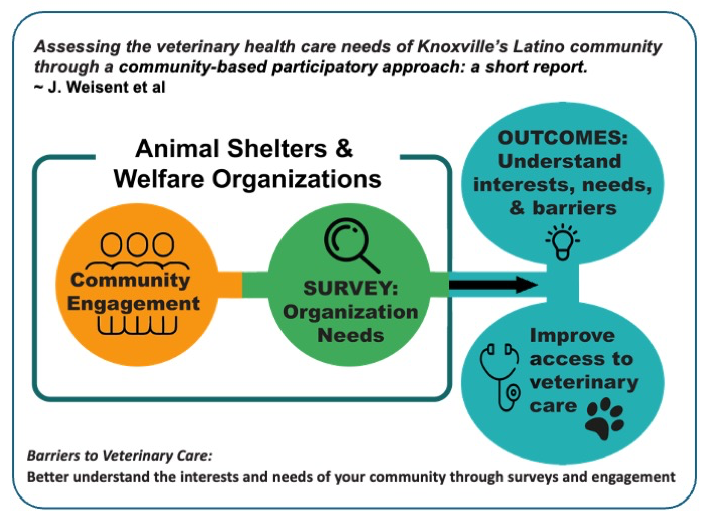Assessing the Veterinary Health Care Needs of Knoxville’s Latino Community Through a Community-Based Participatory Approach: A Short Report
DOI:
https://doi.org/10.56771/jsmcah.v3.78Keywords:
shelter medicine, access to veterinary care, veterinary outreach, underserved pet ownersAbstract
The primary objective of the study was to better understand the interests, needs, and perceived barriers to veterinary care of Knoxville’s Latino community. Investigators adapted a national survey designed to understand access to veterinary care for distribution to the Latino population through a community-based participatory approach with an established community center. Seventy-six percent of survey respondents (n = 46) reported that they consider the pet as part of the family. Forty-eight percent said their pets were not spayed or neutered (s/n), and of these, 39% said s/n was cost-prohibitive, whereas 22% did not know where to receive services. Twenty-six percent identified an inability to obtain treatment for a sick pet, primarily due to a lack of access to affordable care. Participants expressed interest in vaccines and parasite prevention (64%), training and behavior (36%), and information on veterinary and pet care resources (29%). The survey tool (provided in English and Spanish) and community engagement approach can assist animal welfare organizations in identifying and addressing community veterinary needs and barriers to care.
Downloads
References
Wiltzius AJ, Blackwell MJ, Krebsbach SB, et al. Access to Veterinary Care: Barriers, Current Practices, and Public Policy. Access to Veterinary Care Coalition; 2018.
Park RM, Gruen ME, Royal K. Association between dog owner demographics and decision to seek veterinary care. Vet Sci. 2021;8(1):11–18. doi: 10.3390/vetsci8010007
Stull JW, Shelby JA, Bonnett BN, et al. Barriers and next steps to providing a spectrum of effective health care to companion animals. J Am Vet Med Assoc. 2018;253(11):1386–1389. doi: 10.2460/javma.253.11.1386
LaVallee E, Mueller MK, McCobb E. A systematic review of the literature addressing veterinary care for underserved communities. J Appl Anim Welf Sci. 2017;20(4):381–394. doi: 10.1080/10888705.2017.1337515
Neal SM, Greenberg MJ. Putting access to veterinary care on the map: a veterinary care accessibility index. Front Vet Sci. 2022;9:857644. doi: 10.3389/fvets.2022.857644
Hispanic/Latino Health. https://minorityhealth.hhs.gov/hispaniclatino-health. Accessed June 20, 2024.
Zhang X, House L, Salois MJ. An examination of US pet owners’ use of veterinary services, 2006–2018. Vet Med Sci. 2024;10(3):e1370. doi: 10.1002/vms3.1370
King E, Mueller MK, Dowling-Guyer S, McCobb E. Financial fragility and demographic factors predict pet owners’ perceptions of access to veterinary care in the United States. J Am Vet Med Assoc. 2022;260(14):1–8. doi: 10.2460/javma.21.11.0486
Poss JE, Bader JO. Attitudes toward companion animals among Hispanic residents of a Texas border community. J Appl Anim Welf Sci. 2007;10(3):243–253. doi: 10.1080/10888700701353717
Decker Sparks JL, Camacho B, Tedeschi P, Morris KN. Race and ethnicity are not primary determinants in utilizing veterinary services in underserved communities in the United States. J Appl Anim Welf Sci. 2018;21(2):120–129. doi: 10.1080/10888705.2017.1378578
Schoenfeld-Tacher R, Kogan LR, Wright ML. Comparison of strength of the human-animal bond between Hispanic and non-Hispanic owners of pet dogs and cats. J Am Vet Med Assoc. 2010;236(5):529–534. doi: 10.2460/javma.236.5.529
Faver CA. Sterilization of companion animals: exploring the attitudes and behaviors of Latino students in south Texas. J Appl Anim Welf Sci. 2009;12(4):314–330. doi: 10.1080/10888700903163534

Published
Issue
Section
License
Copyright (c) 2024 jennifer Weisent, Rebekah Debolt, Linda M. Daugherty, Alexis Niceley, Jamie Lyn Norris

This work is licensed under a Creative Commons Attribution 4.0 International License.









